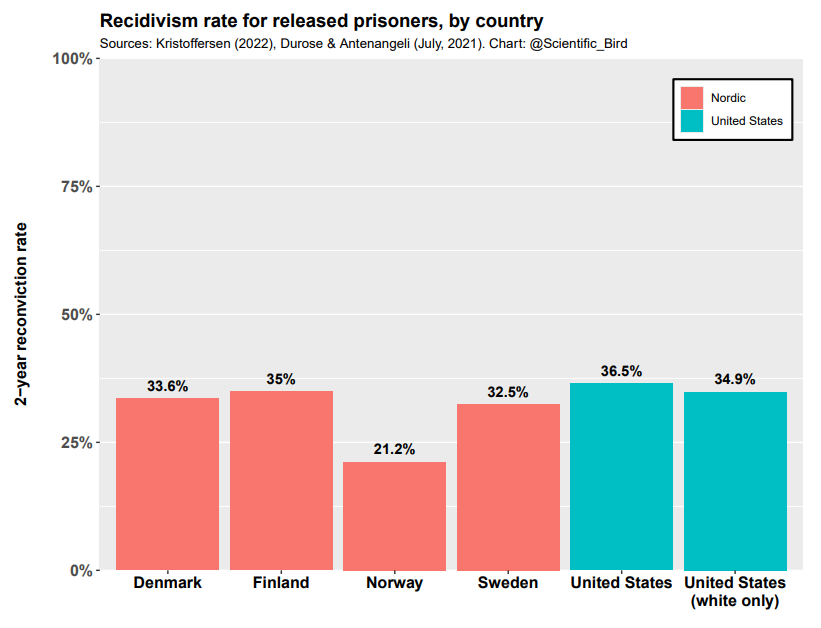Recidivism in Norway
Did rehabilitation reforms dramatically reduce Norwegian recidivism?
Introduction
In my previous piece, I dealt with a number of common misconceptions about Nordic recidivism and rehabilitation. I showed that, contrary to widespread belief, the American recidivism rate is not much higher than that of Sweden, Finland and Denmark.
Norway, however, did have noticeably lower recidivism rate (see below). I argued that a substantial amount of its measured advantage over the other Nordic countries likely cannot be attributed to superior rehabilitation. Still, Norwegian recidivism in particular is worthy of additional investigation.
In a 2019 BBC article, the Norwegian prison governor Are Høidal recalls the ‘80s non-rehabilitative “macho culture.” He says that back then the recidivism rate was “around 60-70%, like in the US.” But following a series of rehabilitation reforms in the early '90s, “recidivism in Norway has fallen to only 20% after two years and about 25% after five years. So this works!” Laroia (2020) repeats these points, writing “After reforming its prison system to one based on rehabilitation and support, though, the efficacy of its prisons in reducing crime skyrocketed.” The Wikipedia page for Incarceration in Norway writes the same, citing the mentioned sources. Many make similar claims. Bleicher (2021), writing about pre-reform recidivism rates, says: “As many as 70% of Norwegians released from prison reoffended within two years.”
This is one of the central arguments used in favor of Norwegian rehabilitation efficacy: while Norway used to have very high recidivism rates, it dramatically fell following rehabilitation reforms. There is just one problem: this story is false. Norway did not have dramatically high recidivism rates prior to these rehabilitation reforms. In fact, their recidivism rates in the ‘60s were lower than they are today.
In this piece, I will address these claims about Norwegian recidivism. I will provide more comprehensive and accurate data tracking recidivism trends. And lastly, I will give a more plausible and empirically supported account of what underlies these trends.
Content
Introduction
Norwegian recidivism rate trends
Explaining Norwegian recidivism trends
Explaining Norway’s low recidivism rate
Conclusion
Appendix
Norwegian recidivism rate trends
Keep reading with a 7-day free trial
Subscribe to Patterns in Humanity to keep reading this post and get 7 days of free access to the full post archives.


